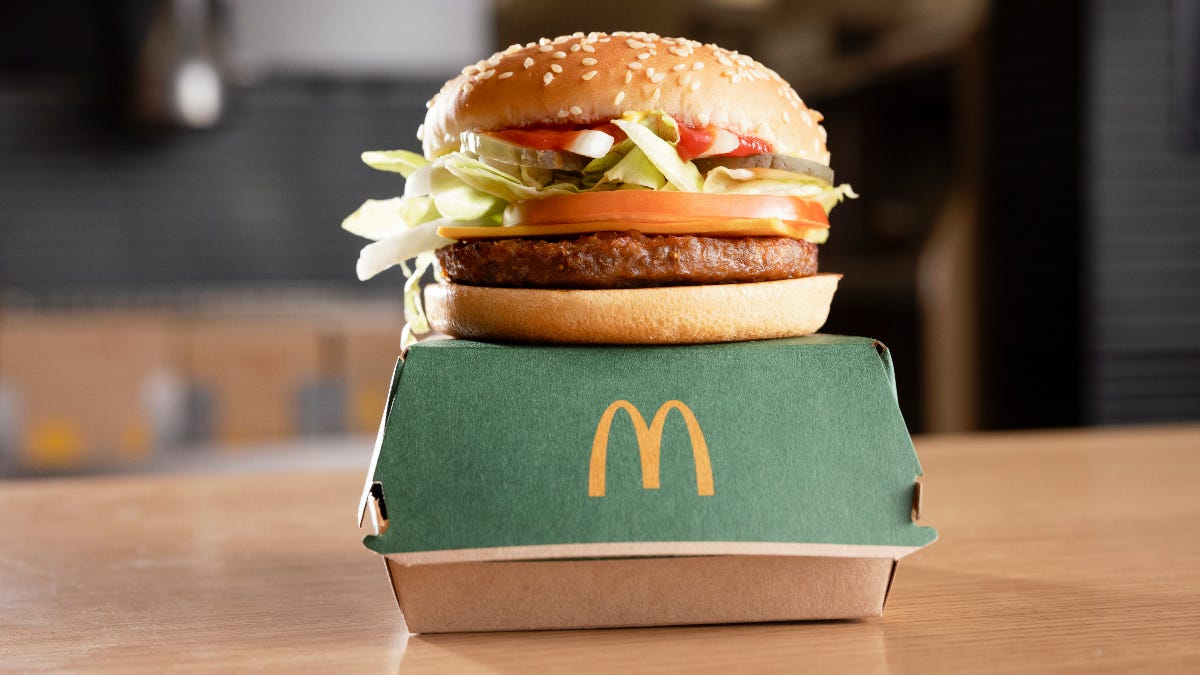Veggie Digest #5
Dairy-free milk made from potatoes, clothing made from muscle protein, vegan chocolate, and much more!
Welcome to the latest installment of the Veggie Digest, the newsletter that keeps you on top of the latest in sustainable food innovations.
Headlines and Trends
A curated roundup of interesting food tech news from the past week.
📰 McDonald’s Vegan McPlant Burger (The Beet)
McDonald’s is launching its plant-based Burger in the United Kingdom. The vegan McPlant will feature a Beyond Meat patty, (as McDonald’s has recently signed a three-year partnership with Beyond Meat) topped with a vegan special sauce, vegan cheese, and served on a completely vegan sesame-seed bun.
📰 Potato Milk May Be the Most Sustainable Option (CBC)
You have heard of non-dairy milk made from oats, almonds, and soybeans, but have you heard about the new competitor: potato milk. The product was developed by Eva Tornberg, a professor at Lund University in Sweden. Potato proteins along with rapeseed oil, chicory fiber, and pea protein make for a nutritious, environmentally friendly dairy substitute. It contains high protein, high starch, and high vitamin C content.
📰 Hershey’s Launches Its First Ever Vegan Chocolate (Vegconomist)
Hershey’s has launched its first-ever vegan chocolate made with oat milk. The vegan chocolate market is rapidly expanding worldwide and is expected to reach 1.41 billion dollars by 2028. The growth is driven by increased environmental awareness and concerns about animal welfare. The bars will come in two flavors — Classic Dark and Extra Creamy Almond & Sea Salt. They are non-GMO and made with Rainforest Alliance certified cocoa.
📰 Vegan Meat Featured On Menus More Since Before Covid-19 (Plant Based News)
AI platform Tastewise found that plant-based meat is appearing on US menus 1,320% more compared to before the emergence of COVID-19. The report stated that the market for plant-based foods already sits at $7 billion in the US alone. Most people are switching to plant-based food mainly for health reasons, but sustainability motivations are increasing by 58% annually.
📰 Protein Digestion Findings Could Inspire New Plant-Based Product Developments (Food Navigator)
In a study that put animal-based ground beef and plant-based ground beef into a simulated gastrointestinal model, scientists found that proteins and lipids were digested differently in both products. Researchers monitored differences in the structure, physicochemical properties, and digestibility of the meat samples while they moved through a simulated human stomach.
📓 The 2021 AgFunder Farm Tech Investment Report (AgFunder)
AgFunder is a leading food-tech venture capital firm. This report gives an overview of key venture trends over the past year in “farm Tech”, a category that includes things like farm robotics, novel farming systems (e.g. vertical farms, aquaculture, insect production), genetics and breeding, and software. Year over year investments increased in 2020 by over 40% despite the pandemic. SPACs (Special Purpose Acquisition Companies, see Wikipedia) gained prominence and played an important role in company exits and the acquisitions landscape. The report also includes profiles of up-and-coming startups like Infarm (vertical farming) and Ÿnsect (insect-based ingredients).
Food Lingo: “Synthetic Biology”
There’s a lot of jargon in the food technology and sustainability space. Each week I highlight an important concept to improve your food lingo literacy.
Synthetic Biology focuses on the design and construction of core biological components such as enzymes, genetic circuits, and metabolic pathways that can be modeled, understood, and tuned to meet specific performance criteria to solve specific problems.
📰 Synthetic Bacteria Can Produce Muscle Fibers Stronger than Kevlar (Extreme Tech)
Researchers may be able to grow muscle fiber that can be used in place of fabrics like cotton, silk, and even Kevlar.
The muscle protein titin is like a molecular spring that gives muscles passive elasticity.
To make large amounts of titin, a team used engineered bacteria by introducing the genes for titin into the genome of E. coli bacteria. The engineered bacteria are able to produce small segments of titin that then are turned into long titin polymers.
Since the titin fibers are stronger than Kevlar, the team believes they could be used for protective clothing or even medical applications.
Sustainability Beyond Food
A handful of non-food-specific pieces to keep you abreast of other environmental items of interest.
🎙️ How Sustainable Are America’s Most Popular Chain Stores? (Good Together)
Popular Chain Stores Walmart, Kroger, Costco, Target, Aldi, Trader Joe’s, and Whole Foods were ranked from least to most sustainable. The rankings were based on consumer-facing sustainability initiatives such as the use of plastic packaging materials, commitments to reduce waste, in-store recycling options, use of sustainable energy, and if they carry sustainable product lines.
📰 Gen Z Flocks To Climate Careers (The Guardian)
Surveys continuously show that young people are not just incorporating climate-conscious behaviors into their everyday lives. College administrators say that there is a rapidly increasing number of students who are pursuing environmental-related degrees and careers that were once considered “irresponsible, romantic flights of fancy.” The United States Bureau of Labor Statistics projects that employment opportunities for environmental scientists and environmental-related fields will grow 8% over the next 10 years.
📰 Carbon Removal Technology Reaches Early Milestone (E&E News)
The world’s largest facility dedicated to removing carbon dioxide from the atmosphere is set to come online in Iceland. If it works as planned, the plant would increase the world’s direct air capture capacity by more than 40%, to 13,000 metric tons. The plant is named “Orca,” and energy experts claim that it could someday complement efforts to reduce the release of greenhouse gases.
—-
Thank you for reading the Veggie Digest newsletter. If you’re enjoying it, be sure to share it with your friends and colleagues.
If this newsletter was forwarded to you, visit this link to subscribe.
You can reach me by replying directly to this email or by adding a comment on Substack.




